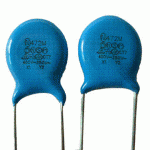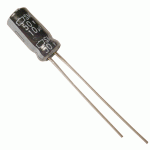The words particle and wave are two words you’ll see in nearly every area of physics, but they are actually very different from each other. A particle is a tiny concentration of something that can transmit energy, and a wave is a broad distribution of energy that fills the space it passes through. We’re going to look at particles in more depth later, and instead focus on understanding waves.
Please login or register to read the rest of this content.
Sound is a type of energy, and energy moves by waves. So sound moves from one place to another by waves; longitudinal waves to be more specific. So, how fast do sound waves travel? Well, that’s a bit of a tricky question. The speed of the wave depends on what kind of stuff the wave is moving through. The more dense (thicker) the material, the faster sound can travel through it.
Please login or register to read the rest of this content.
Sound moves faster in solid objects than it does in air because the molecules are very close together in a solid and very far apart in a gas. For example, sound travels at about 760 mph in air, 3300 mph in water, 11,400 mph in aluminum, and 27,000 mph in diamond!
Please login or register to read the rest of this content.
Ever gotten sea sick? It’s usually because the motion of what your body detects is different from what your eyes see. Let’s take a look at how you can calculate the wave speed by watching two boats bobbing up and down (without getting sick).
Please login or register to read the rest of this content.
If a wave can travel through mediums like air, water, strings, rocks, etc., then it makes sense that as the wave moves through these mediums, the tiny particles that make up the medium will also vibrate. In order for this to happen, the medium has to have a way for energy (both potential and kinetic) to be stored, so the medium has both inertia and elasticity.
Please login or register to read the rest of this content.
It’s easy to see how the current flows through a circuit that has only one component, like one LED connected to the battery. If it’s a 3 Volt battery, then there’s 3 Volts across the LED also.
But what if there are two or three LEDs? How does the voltage look across each one? What if the LEDs are different sizes? Does it matter how you hook them up, meaning does one way make the LED last monger or glow brighter? Let’s take a look at the difference between series and parallel connections.
Please login or register to read the rest of this content.
Each electrical component is connected so that there’s only one option for the current to flow. There’s no branches or alternate routes for the electricity… it’s only got one way to move through the circuit. When you add more electrical components, like motors or LEDs to this circuit, the overall resistance in the circuit decreases since there’s only one path for the current.
Please login or register to read the rest of this content.
Each device, like a motor or LED, has its own branch lines in a parallel circuit, which means that the electricity has many different ways that it can travel along the circuit lines. When scientists and engineers draw electrical diagrams, they put one electric component on each branch, even if in reality there’s more than one when you actually build the thing.
Please login or register to read the rest of this content.
Current and charge aren’t quite the same thing. Current is rate that charge goes through a circuit (just like acceleration is the rate of change in velocity… acceleration and velocity aren’t the same thing either, but they are related). Remember, charge doesn’t get used up by electrical components like LEDs or resistors.
Please login or register to read the rest of this content.
One more thing to note about the difference between series and parallel circuits is that in a parallel circuit, the current in each branch can be different, but they all add up to be the same everywhere once you reduce the branches into a single branch. Just like the water analogy, when you connect the main hose into five different smaller hoses, the sum of all five is going to equal flow through the main hose.
Please login or register to read the rest of this content.
It’s easy to get sucked into doing math and equations all day without understanding how it applies to the real world. Let’s take a look at how to actually hook up series and parallel circuits in everyday life, and how they are different, and when to use each one…
Please login or register to read the rest of this content.
Although you can’t see electricity, you can certainly detect its effects – a buzzer sounding, a light flashing, a motor turning… all of these happen because of electricity. Which is why electricity experiments are among the most frustrating. You can’t always tell where the problem is in a circuit that refuses to work right.
We’re going to outline the different electronic components (resistors, capacitors, diodes, transistors, etc) so you get a better feel for how to use them in a circuit. While we’re not going to spend time on why each of these parts work (which is a topic best reserved for college courses), we are going to tackle how to use them to get your circuit to do what you want. The steps to building several different electronics projects are outlined very carefully so you can really understand this incredible micro-world.
In this video, you’ll learn how to identify each electronic component. You’ll also learn how to use a breadboard to quickly build circuits that can be easily changed. Plus, you’ll learn how to make sure you don’t damage your components.
Before you use a breadboard, you need to know how the “holes” in it connect to each other. Once you get this, they’re easy to use, but until you understand their secret, they can be totally confusing. Be sure to pay attention to this part, and it will make things a lot easier. Once you have this down, you’ll wire up a few simple circuits on the breadboard just to try out your new knowledge.
Which part is which? Click here to access a reference sheet so you can tell which resistor is which.
Please login or register to read the rest of this content.
Click here to go to your next lesson on Series Switches.
We’ve seen how switches can be used to turn stuff on and off, now let’s take a look at how a switch in different locations can turn the same thing on or off. A lot like a doorbell with a button at the front door and a button at the back door.
Please login or register to read the rest of this content.
Click here to go to your next lesson on Light Actuated Circuit.
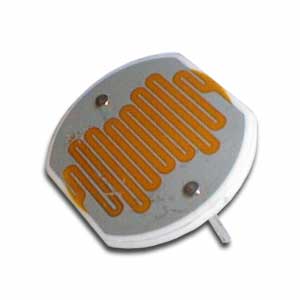
In this circuit, we’re going to use a special kind of resistor, called a CdS photocell to detect light and dark. When light is shined on the photocell, the LED will light up. When it is dark, the LED goes out. And with just a little light, the LED is dim. Remember the explanation of how a transistor works? We talked about having a small voltage (or current) control a larger one, kind of like turning the knob on a light switch dimmer in your house? That’s what this circuit is doing.
The photocell is a kind of resistor that changes it’s resistance depending on how light or dark it is. In this circuit, when it is light, the photocell delivers more current to the base lead of the transistor. When this happens, the transistor allows more voltage to flow from the emitter lead to the collector lead, which in turn lights up the LED. One resistor are simply used to reduce the amount of current that goes into the transistor (so it doesn’t get too much current) if the photocell has a really low resistance because of how much light is on it. The other one is called a pull-down resistor. Think of it like a door closer spring for electricity. A door closer closes the door when you let go of it (instead of leaving the door to sway in the wind). A pull-down resistor makes sure that when the transistor is “off”, it will “spring” toward a connection to the negative side of the battery (a pull-up makes it spring toward the positive).
Please login or register to read the rest of this content.
Click here to go to your next lesson on Light De-actuated Circuit.
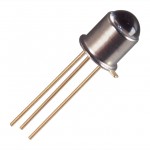 Make sure you’ve already made the Light Actuated Circuit before starting this project!
Make sure you’ve already made the Light Actuated Circuit before starting this project!
Photoresistors (also called CdS photocells) are made of a material that reacts with light, very similar to solar cells. When light hits the material, it knocks a few electrons loose. When you hook up the cell to a circuit, the electrons now have a place to go, and electricity flows through your wires. You’ll notice your CdS cell works when you shine a light on it from either the front side or the back side. If you want to use a phototransistor, make a note as to the frequency of light it’s been tuned to – some will only work with IR light (like your remote control or sunlight).
In this circuit, the LED is actuated only when the photoresistor is dark. If you want a faster response to your light, you can substitute a phototransistor for the photoresistor (CdS cell) and adjust the value of the 1-kOhm resistor (change it lower or higher, or use a potentiometer) to control the sensitivity.
This is basically the same as the light-actuated circuit. The difference is that the transistor is connected to control power to the LED in the opposite way as the light-actuated circuit. So, as there is more light on the photocell (and the base lead gets more current), the voltage to the transistor is reduced.
Click here for Unit 14 (Lesson 1) schematics.
Notice what is the same in the circuit, and what is different.
Please login or register to read the rest of this content.
Click here to go to your next lesson on How to Read Schematics.
Do you remember the first time you tried to read a map? There were all those weird symbols and curving lines that you had to figure out before you could get anywhere. Electric circuits are kind of the same way… people use schematic diagrams to write down how their circuit is wired so others can build it, too.
Please login or register to read the rest of this content.
This Flashing Circuit used to be a real ‘wowser!’ with students before LEDs become commonplace (around 1995). You’re going to build a circuit that has a control knob that will allow you to set the flash speed of the LED. You can try different LEDs or mini-lamps to see what kind of an effect you get. Are you ready?
NPN and PNP transistors are similar in that when current is applied to the base, electricity flows through them. But, they way they are used is different. NPN transistors are often used to control whether a circuit is completed by connecting it to ground or not, where PNP control the positive current going into a device (or portion of a circuit). NPN transistors are often used where larger currents need to be controlled, because it’s easier for a transistor to control the ground side of a circuit than the plus power side of it.
So, why does the LED flash? Remember, a capacitor is like a storage tank for electricity. You fill it up, then empty it out. But, it takes time to fill up and empty. This circuit uses the time it takes to fill and empty as a delay for turning the LED on and off. How fast it fills up depends on the value of the resistor that is connected to it. We’re using a variable resistor, so we can adjust how fast it fills up, and thus adjust the flash rate.
Click here for Unit 14 (Lesson 1) schematics.
Please login or register to read the rest of this content.
Click here to go to your next lesson on Audible Probes.
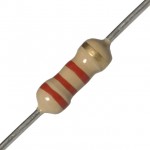 Resistors look like candy-striped hot dogs. Their job is to limit current to keep sensitive electronics from being overloaded. If you break open a resistor, you’ll find a pile of graphite. If you have a digital multimeter, draw a line on a sheet of paper with a graphite pencil, and place one probe near the end of the line. You can measure the change in resistance along the line with your other multimeter probe!
Resistors look like candy-striped hot dogs. Their job is to limit current to keep sensitive electronics from being overloaded. If you break open a resistor, you’ll find a pile of graphite. If you have a digital multimeter, draw a line on a sheet of paper with a graphite pencil, and place one probe near the end of the line. You can measure the change in resistance along the line with your other multimeter probe!
Make sure you’ve made the Light Flasher before starting this circuit. This circuit, the Audible Light Probe, is actually a very sensitive circuit that will emit all sorts of sounds reminiscent of junior high school boys locker rooms. The frequency from the speaker will change as the light intensity changes. One of the neat features about this circuit is that it will allow you to test different transistors (both PNP and NPN) to see (hear) the changes. You can also play with the capacitor and resistor values to change the range.
Click here for Unit 14 (Lesson 1) schematics.
TIP: If your tones won’t stop, or are too high to hear, try operating your circuit in a very dark room before adding the light. Can you get your speaker to *click*?
Please login or register to read the rest of this content.
Click here to go to your next lesson on Lie Detectors.
Lie Detectors are electronic circuits that are able to measure your skin’s resistance. When you sweat (or if your skin is wet), the resistance is different than if it’s dry.
However since most people don’t sweat when they lie, this type of detector isn’t the most reliable type of detector around, but it’s one of the simplest to create. We’re going to build one from simple electronic components like resistors, capacitors, and transistors.
Our lie detector uses a speaker that changes pitch depending on the resistance of your skin – it’s much more entertaining than blinking an LED on or off. You can think of this circuit as more of a skin humidity indicator. Are you ready?
Please login or register to read the rest of this content.
As electrons move through a load in an electric circuit (devices like a LED, buzzer, motor, etc.), they experience resistance (even through the wire itself), which corresponds to a drop in energy . This drop in energy is referred to as a voltage drop. Resistance hinders the flow of electrons, even in the water itself. You can think of resistance as the friction between the water and the pipe along the inside of the pipe.
The pipe, just like the wire, has a certain diameter and length. The longer the wire, the more resistance the electron will encounter, just as with a long pipe of water. If you increase the pipe diameter, more water will flow through it. The thicker the wire, the more current flows through it. The amount of resistance the charge encounters also depends on what the wire is made out of. Certain materials are more electrically conductive than others, with silver, copper and gold being at the very low end of electrical resistance (which is why most wires are made from copper, which is the least expensive of the three).
Please login or register to read the rest of this content.
Resistors are a very important part of electronics, in fact without them we wouldn’t even have electronics. Resistors help us control the flow of current through a circuit and protect components from being damaged. This video talks about what resistors are, how to read them, and how to use them.
Please login or register to read the rest of this content.
Click here to go to your next lesson on Potentiometers.
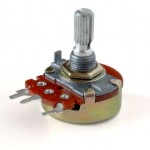 So now you know how to hook up a motor, and even wire it up to a switch so that it goes in forward and reverse. But what if you want to change speeds? This nifty electrical component will help you do just that.
So now you know how to hook up a motor, and even wire it up to a switch so that it goes in forward and reverse. But what if you want to change speeds? This nifty electrical component will help you do just that.
Once you understand how to use this potentiometer in a circuit, you’ll be able to control the speed of your laser light show motors as well as the motors and lights on your robots. Ready?
Please login or register to read the rest of this content.
 One of the most useful tools a scientist can have! A digital multimeter can quickly help you discover where the trouble is in your electrical circuits and eliminate the hassle of guesswork. When you have the right tool for the job, it makes your work a lot easier (think of trying to hammer nails with your shoe).
One of the most useful tools a scientist can have! A digital multimeter can quickly help you discover where the trouble is in your electrical circuits and eliminate the hassle of guesswork. When you have the right tool for the job, it makes your work a lot easier (think of trying to hammer nails with your shoe).
We'll show you how to get the most out of this versatile tool that we're sure you're going to use all the way through college. This project is for advanced students.
Please login or register to read the rest of this content.
Click here to go to your next lesson on Ohm's Law.
One of the most important equations in current electricity is: V = IR. With one glance, you can see how current, voltage, and resistance are related to each other. If the current decreases, so does the voltage. Charge mores when the resistance decreases.
Please login or register to read the rest of this content.
Imagine you have two metal plates that are parallel to each other, and one is positively charged ad the other is negatively charged. The direction of the electric field created by these two charged places is from the positive toward the negative plate. (Imagine placing a positive test charge int he field… which way would it go? Away from the positive plate and toward the negative plate… so that’s the direction of the electric field.) Now imagine connecting the two plates with a metal wire. What do you think would happen?
Please login or register to read the rest of this content.
An electrical circuit is like a NASCAR raceway. The electrons (racecars) zip around the race loop (wire circuit) superfast to make stuff happen. Although you can’t see the electrons zipping around the circuit, you can see the effects: lighting up LEDs, sounding buzzers, clicking relays, etc.
There are many different electrical components that make the electrons react in different ways, such as resistors (limit current), capacitors (collect a charge), transistors (gate for electrons), relays (electricity itself activates a switch), diodes (one-way street for electrons), solenoids (electrical magnet), switches (stoplight for electrons), and more. We’re going to use a combination diode-light-bulb (LED), buzzers, and motors in our circuits right now.
A CIRCUIT looks like a CIRCLE. When you connect the batteries to the LED with wire and make a circle, the LED lights up. If you break open the circle, electricity (current) doesn’t flow and the LED turns dark.
LED stands for “Light Emitting Diode”. Diodes are one-way streets for electricity – they allow electrons to flow one way but not the other.
Remember when you scuffed along the carpet? You gathered up an electric charge in your body. That charge was static until you zapped someone else. The movement of electric charge is called electric current, and is measured in amperes (A). When electric current passes through a material, it does it by electrical conduction. There are different kinds of conduction, such as metallic conduction, where electrons flow through a conductor (like metal) and electrolysis, where charged atoms (called ions) flow through liquids.
Please login or register to read the rest of this content.
Click here to go to your next lesson on Detecting Current!
Galvanometers are coils of wire connected to a battery. When current flows through the wire, it creates a magnetic field. Since the wire is bundled up, it multiplies this electromagnetic effect to create a simple electromagnet that you can detect with your compass.
Please login or register to read the rest of this content.
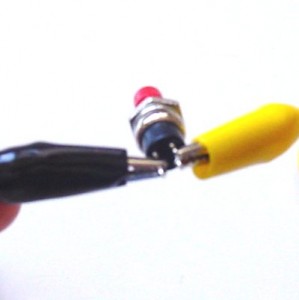 Make yourself a grab bag of fun things to test: copper pieces (nails or pipe pieces), zinc washers, pipe cleaners, Mylar, aluminum foil, pennies, nickels, keys, film canisters, paper clips, load stones (magnetic rock), other rocks, and just about anything else in the back of your desk drawer.
Make yourself a grab bag of fun things to test: copper pieces (nails or pipe pieces), zinc washers, pipe cleaners, Mylar, aluminum foil, pennies, nickels, keys, film canisters, paper clips, load stones (magnetic rock), other rocks, and just about anything else in the back of your desk drawer.
Certain materials conduct electricity better than others. Silver, for example, is one of the best electrical conductors on the planet, followed closely by copper and gold. Most scientists use gold contacts because, unlike silver and copper, gold does not tarnish (oxidize) as easily. Gold is a soft metal and wears away much more easily than others, but since most circuits are built for the short term (less than 50 years of use), the loss of material is unnoticeable.
Please login or register to read the rest of this content.
Click here to go to your next lesson on requirements for a circuit!
You need two important things for an electric circuit: first you need a closed conductive path that goes from the positive to the negative terminal of the battery. When I teach this activity to kids, there’s always a couple that try to light up the LED just using the LED and wires (they forget about the battery completely!) You always need a power source in the circuit in order for charges to flow. The charges only flow through something that conducts electricity. Sometimes kids forget about the conductive part, and just try to touch the plastic coating on the wires to the LED and are frustrated when it doesn’t work right. It must be a closed conductive loop.
Please login or register to read the rest of this content.
This is a recording of a recent live robotics teleclass I did with thousands of kids from all over the world. I’ve included it here so you can participate and learn, too!
We’ll cover topics in electricity, magnetism, electrical charges, robot construction, sensors and more by building several projects together. For now, just watch the video and if you already have the materials to build the projects, feel free to do it along with me. If not, don’t worry… we’ll get to these projects soon in the course.
Please login or register to read the rest of this content.
If this next part is too confusing, just skip over it. I did want to let you know (for those of you who have spotted it already) that there’s a big problem with the positive test charge model we’ve been using. Well, it’s kind of a problem, but not really a big one once you get used to the idea.
Please login or register to read the rest of this content.
In electric circuits, the charge carriers are electrons, which are already inside the wire itself. The battery doesn’t add extra electrons to the circuit to make it go… the electrons inside the wires are already there. The battery provides an electric potential difference that signals the electrons to start moving, and this signal travels at the speed of light (or close to it), and then the electrons start moving (quite a bit slower than the speed of light). This means that electrons don’t have to start at the battery and them go all the way to the light before the light bulb lights up, because the electrons inside the filament itself are the ones that start glowing when they get the signal to start moving.
Please login or register to read the rest of this content.
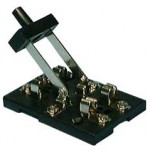 When you turn on a switch, it’s difficult to really see what’s going on… which is why we make our own from paperclips, brass fasteners, and index cards.
When you turn on a switch, it’s difficult to really see what’s going on… which is why we make our own from paperclips, brass fasteners, and index cards.
Kids can see the circuit on both sides of the card, so it makes sense why it works (especially after doing ‘Conductivity Testers’).
SPST stands for Single Pole, Single Throw, which means that the switch turns on only one circuit at a time. This is a great switch for one of the robots we’ll be making soon, as it only needs one motor to turn on and off.
Please login or register to read the rest of this content.
Click here to go to your next lesson on Electric Circuit Loads!
Imagine you have two magnets. Glue one magnet on an imaginary record player (or a ‘lazy susan’ turntable) and hold the other magnet in your hand. What happens when you bring your hand close to the turntable magnet and bring the north sides together?
The magnet should repel and move, and since it’s on a turntable, it will circle out of the way. Now flip your hand over so you have the south facing the turntable. Notice how the turntable magnet is attracted to yours and rotates toward your hand. Just as it reaches your hand, flip it again to reveal the north side. Now the glued turntable magnet pushes away into another circle as you flip your magnet over again to attract it back to you. Imagine if you could time this well enough to get the turntable magnet to make a complete circle over and over again… that’s how a motor works!
After you get the buzzer and the light or LED to work, try spinning a DC motor:
Please login or register to read the rest of this content.
We’re going to define power in an electric circuit as the rate tat electrical energy is used by the load (or supplied by the source). Power is then equal to the work done by the charge per unit time, or said another way, the rate that the charge changes its energy (whether it’s lost or gained).
Please login or register to read the rest of this content.
A lot of people don’t understand electricity, but they use it all the time. Normally I’d agree with this approach: know enough so you can make good use of it, and for the most part, I’ve done that in this course. However, because this is such an advanced course specifically in electricity, I want to make sure we’ve busted the main myths out there around electricity, Over the years, I’ve heard many different ideas folks have about electricity, and at some level, it’s really not their fault for these misconceptions because they are still so popular.
It’s important as a scientist that you question not only what you know but how you know what you know. This will lead you to the truth about how things work, and not just what most people think the reason is (which isn’t usually correct). Here are a couple of mainstream ones that still persist today:
Please login or register to read the rest of this content.
Please login or register to read the rest of this content.
Magnesium is one of the most common elements in the Earth’s crust. This alkaline earth metal is silvery white, and soft. As you perform this lab, think about why magnesium is used in emergency flares and fireworks. Farmers use it in fertilizers, pharmacists use it in laxatives and antacids, and engineers mix it with aluminum to create the BMW N52 6-cylinder magnesium engine block. Photographers used to use magnesium powder in the camera’s flash before xenon bulbs were available.
Most folks, however, equate magnesium with a burning white flame. Magnesium fires burn too hot to be extinguished using water, so most firefighters use sand or graphite.
We’re going to learn how to (safely) ignite a piece of magnesium in the first experiment, and next how to get energy from it by using it in a battery in the second experiment. Are you ready?
Please login or register to read the rest of this content.
Click here to go to your next lesson on how to make a fruit battery.
This experiment shows how a battery works using electrochemistry. The copper electrons are chemically reacting with the lemon juice, which is a weak acid, to form copper ions (cathode, or positive electrode) and bubbles of hydrogen.
These copper ions interact with the zinc electrode (negative electrode, or anode) to form zinc ions. The difference in electrical charge (potential) on these two plates causes a voltage.
Materials:
- one zinc and copper strip
- two alligator wires
- digital multimeter
- one fresh large lemon or other fruit
Click here to go to your next lesson on learning how a battery can store energy.
Why is one end designated as the “high potential” end? If you watch a positive charge move from the negative terminal to the positive terminal, it requires work to move this charge (the positive charge experiences a repulsive force as it moves closer to the positive terminal), which increases the potential energy of the charge because you’re moving a positive charge against the electric field.
Please login or register to read the rest of this content.
Moving the positive charge from the positive to negative terminal would be with the electric field, so the charge would experience a decrease in potential energy as it moved through an external circuit. (You’ve noticed that we’re only talking about positive test charges here in order to determine which end of the battery is high and which end is low.) This is a really neat experiment on how to make your own solar battery. If you don’t have time or copper flashing for this one, you can just skip doing it but be sure to watch it just for fun…
Please login or register to read the rest of this content.
Using ocean water (or make your own with salt and water), you can generate enough power to light up your LEDs, sound your buzzers, and turn a motor shaft. We’ll be testing out a number of different materials such as copper, aluminum, brass, iron, silver, zinc, and graphite to find out which works best for your solution.
This project builds on the fruit battery we made in Unit 8. This experiment is for advanced students.
The basic idea of electrochemistry is that charged atoms (ions) can be electrically directed from one place to the other. If we have a glass of water and dump in a handful of salt, the NaCl (salt) molecule dissociates into the ions Na+ and Cl-.
When we plunk in one positive electrode and one negative electrode and crank up the power, we find that opposites attract: Na+ zooms over to the negative electrode and Cl- zips over to the positive. The ions are attracted (directed) to the opposite electrode and there is current in the solution.
Please login or register to read the rest of this content.
Have you ever wondered what college will be like? Here’s a video from a professor at MIT on electrostatics, specifically the electric field and the electric potential. It’s a full class lecture, so don’t worry if you get a little lost with the calculations on the chalkboard. Just sit back and enjoy watching learning from someone other than me (Aurora) so you get more than one perspective on the subject.
Click here to go to your next lesson on voltage.
Imagine you have a positive test charge in an electric field and you move it from one point to another. When you move it, the charge against the electric field, you have to do work on it using an external force, like your hand pushing it along the path. The work done by your hand on the charge will increase the potential energy and also cause a difference in the electric potential between the start and finish locations. If the electric potential difference between the start and finish is 10 volts, then one Coulomb of charge will increase by 10 Joules of potential energy when you push the charge from start to finish. This is what voltage is.
Please login or register to read the rest of this content.
Now imagine a simple circuit that uses a light bulb (or LED) and a battery. The battery provides the energy to do work on the charges to move it from the negative to the positive terminal. Once the charge is at the high potential (the plus side of the battery), it’s like taking a chair lift to the top of a mountain… it is now ready to ski down the mountain with little to no effort. So once the charge is at the high potential terminal, it naturally flows through the wires to the low potential terminal. The ski lift is doing work to get you up the mountain against the nature of the gravitational field the same way the battery is doing work on the electric charge moving it from a low to high potential.
Please login or register to read the rest of this content.
Now you understand how scuffing along a carpet in socks builds up electrons on the body, and how this negative electric charge affects other things (like your cat) when you reach a finger out to touch them. You also know how opposite charges attract and like charges repel, and the difference between balanced charges and unbalanced charges.
We’re going to dive into studying force fields. You may wonder what force fields have to do with a serious examination of physics like the one in this lesson. You probably consider force fields to be something you might hear about in a science fiction scene such as…
Please login or register to read the rest of this content.
Overall, Maxwell’s four equations describe the fundamentals of electricity and magnetism. However, one look at these mathematical equations can make a high school student run screaming from the room, so we’re not going to dive into the sophisticated mathematics of the equations themselves, but rather what they really tell us about the relationships between the electric and magnetic fields.
Please login or register to read the rest of this content.
A field changes the nature of the space surround the thing producing the field. A magnet produces a magnetic field which changes the nature of the space around it so that other magnets and magnetic objects are now influenced by it. Some magnetic fields (and other fields) are stronger than others, and now we’re going to learn how to measure the field strength of electric fields.
The electric field is a vector (it has magnitude and direction), and this is how you do it:
Please login or register to read the rest of this content.
Michael Faraday was the first to come up with the idea about electric fields. He thought of the space around a charged object as being filled with lines of force. He was trying to figure out a pattern that represented what the electric field looked like by imagining the electric field as a bubble around a charged object and how it would interact with another object that enters into that bubble. This is a little different than imagining a charge interacting with a charge. There’s a field interaction between the two charges. Every charge creates a bubble around it that in turn, affects the space within that bubble.
Please login or register to read the rest of this content.
Have you wrapped your mind around static electricity yet? You should understand by now how scuffing along a carpet in socks builds up electrons, which eventually jump off in a flurry known as a spark. And you also probably know a bit about magnets and how magnets have north and south poles AND a magnetic field (more on this later). Did you also know that electrical charges have an electrical field, just like magnets do?
It’s easy to visualize a magnetic field, because you’ve seen the iron filings line up from pole to pole. But did you know that you can do a similar experiment with electric fields?
Here’s what you need:
- dried dill (spice)
- vegetable or mineral oil
- 2 alligator wires
- static electricity source (watch video first!)
Click here to go to next lesson on Weird Shapes and Field Lines.

Michael Faraday also discovered how you can have an electric field inside a charged conductor. Image you have a room within a room, and the inner room is made completely of metal. You can sit in the inner room with a static charge detector (like an electroscope), and when you charge the surfaces of both rooms, you’ll see sparks flying between the two rooms, but it’s peacefully (electrically speaking) quiet in the inner room. No charge is detected inside the inner room with your electroscope. You can have a bolt of lightning strike the inner room, but it still doesn’t register a charge inside the inner room. Why is that?
The inner room I’ve just described is called a “Faraday Cage”, and it’s often seen at science and magic shows because it absolutely defies common sense, until you really think about it. The inner room is shielding you from electric fields. Any closed conducting surface can be a Faraday cage. By closed, I mean electrically speaking. The cage can be a cage made of bars or chicken wire, but it’s still got to be electrically closed. During the experiment, you can even run your hands on the inside of the room and still not get a shock from the sparks flying around between the rooms!
Please login or register to read the rest of this content.

